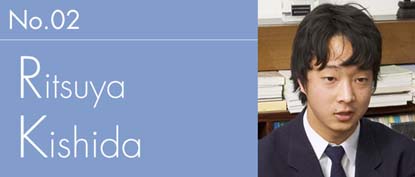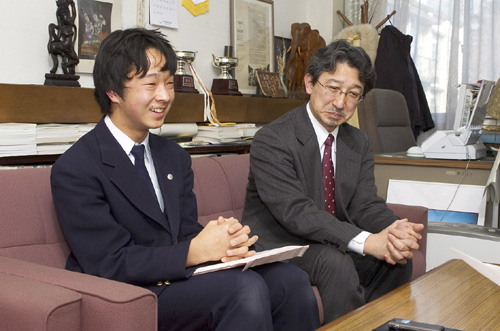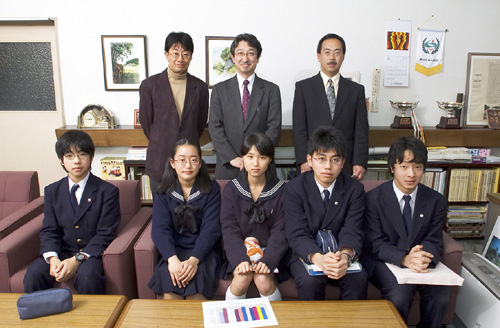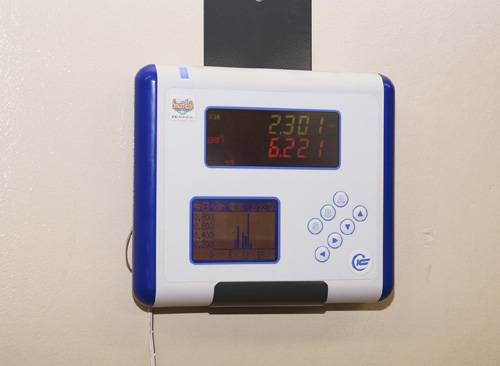Environmental Activity Interviews

Name
Rituya Kishida
-A circle of environmental activities started up with one junior high school student
Oizumi Junior High School Attached to Tokyo Gakugei University stands in a quiet residential area. With the student council at the core, momentum is gathering for environmental activities among the students mainly around the theme of energy conservation. Each room has a device called Energy Conservation Navigation System which gathers data on electric energy usage in the classroom. Students analyze and utilize the data toward energy conservation activities. Students' families, about fifty households in all, actively participate in this effort as well. As a result, in 2005, Oizumi Junior High School was identified as a model school promoting energy conservation. The efforts toward environmental activities only seem to intensify further in the future, but how were they able to come this far? There was a key person holding it all together behind the scenes, the student council president Ritsuya Kishida. We followed him through his activities.
-The encounter with the theme of his activities, "The Destruction of the Ozone Layer"
Ritsuya lived in the United States until he returned to his native Japan in the sixth grade. It was then that he came across and became interested in the ozone layer at the local eco-club he joined. Since he lived in an area rich with nature, environmental issues never seemed to hit home with him during his life in the US. However through his participation in activities at the eco-club, for the first time he learned that the destruction of the ozone layer was causing global warming. He also learned it could only get worse in the future. The more he researched the topic and nurtured his interest in environmental activities, his heart became more intensely drawn to this new theme. Although he soon entered junior high school and his life became to be occupied by other after school activities, his feelings for environmental activities never left him.
-Participation at the Summit brought him back to the activities
It was completely by accident that he met a JUNEC official visiting his school amidst his busy junior high school life revolving around after school activities and personal interests. Already interested in the environment from before, Ritsuya decided to join JUNEC after listening to the speech on that day. He then was recommended by the association to apply for the Children's World Summit for the Environment and later was selected to as a member on the Junior Board. Around this time he started to think about ways for his school to participate in environmental activities, which led him to run for a post on the student council. Back then, the student council had not been taking any active roles in environmental problems although it was working on beautification activities of the school. He was driven by the sense of vocation to become a council member himself and widely disseminate the message on the environment.
-The handout on activity reports which added momentum to the efforts
When he finally joined the student council, Ritsuya recalls, running the council was a lot of work in itself and he had no chance to mention anything regarding the environment. It was the activity report on JUNEC and the Summit that provided him with the chance to make a remark on it. Ritsuya had been writing these reports after every event he attended, and his teacher, with certain hope, decided to hand them out to all students. As a result, the awareness toward the environment rose among many students and there were more hands eager to take part in the activities. "The handout enabled many to learn about my feelings toward the environment and of my activities. Many students started talking to me about it," says Ritsuya. Around this opportune time, Oizumi Junior High School was identified as a model school promoting energy conservation. With the introduction of the Energy Conservation Navigation System, environmental activities only became accelerated. Recently they have come as far as getting the residents around the school involved in the activities. It all started when Ritsuya joined the Summit as a Junior Board member.
-Participants at the Summit gave Ritsuya the courage to continue on with the activities
"People could easily get engrossed in talks about the environment in the US, but it is not the same in Japan. I had wanted to appeal to many others about the environment, but it was difficult to talk to my friends about it," said Ritsuya when being asked about the greatest obstacle he encountered during his activities. "Stressing the seriousness of the problem was difficult. I pondered what to do to raise the awareness toward the environment in others' minds," he added. He also told us that with the installation of the Energy Conservation Navigation System, he was hopeful Oizumi Junior High School could set a model with their environmental activities for other schools. According to Ritsuya, his source of energy toward activities comes from having met many friends from around the globe at the Summit. They gave him the courage to carry on.
-Joining the Summit could change one's notion of nature
The 2005 Children's World Summit for the Environment not only invigorated Ritsuya but also greatly affected the way he saw the environment. "Although environmental issues are hot topics around the world, most people are ignorant of what they could do to help. I myself had many gray areas. However, by taking part in the Summit, it became clear to me there were many things that I could do daily to help. At home, for instance, small efforts like trying to cut down on water usage could lead to energy conservation. If every person was committed to small efforts like this, it could lead to a huge result," said Ritsuya enthusiastically. Like he says, rather than making a big thing about the environment, there are many small things we could do in our daily lives to help.
-His feelings for the environment firmly passed on to the next generation
In the spring of 2006, Ritsuya will proudly graduate from Oizumi Junior High School. The efforts which Ritsuya had started, and continued to be at the center of, don't seem to be growing dim. On the contrary, they seem to be growing stronger. The next generation student council members have surely inherited Ritsuya's DNA. The new council president Kuroda says, "It's important that we carry on the torch lit by Ritsuya, and then to expand our activities toward energy conservation even further. We would like to exchange ideas with other schools involved in environmental activities as well as disseminate information on this issue more eagerly." There has been an idea among them to hold an Energy Conservation Contest in which the students compete in classes to reduce the usage of electric power measured by the Energy Conservation Navigation System. There have already been some new achievements at the school. For instance, the Environmental Club, a strong going after school club of ten years, received the highest award for their presentation entitled "Testing the Degree of Pollution of the Polar Regions Using Soap Bubble," at the Second Open Forum on the South and North Pole by Junior High and High School Students.
-The feeling toward environmental activities growing stronger than ever
We have asked Ritsuya what his next effort would involve. "Aside from energy conservation, I've always been interested and have been doing research on global warming and the destruction of the ozone layer. My newest interest is forestation. It would be best if we could plant trees ourselves but is very difficult for financial reasons. It is a challenge we face." Ritsuya understands that environmental issues should not be ignored. He is highly motivated to express his views on these issues, no matter how small a scale it may be on, even after entering high school. "I definitely will continue to take part in JUNEC and in the Youth Summit if it is held in the future," said Ritsuya with firmness in his voice.
-An Interview with Vice Principal Mr. Kiichirou Narita * Ritsuya planted seeds which will flourish in generations to come
Oizumi Junior High School had the tradition of collecting old milk cartons as part of the student council's activities. It started more than ten years ago in the early 90's when environmental issues were being paid no attention to in the world. However, with the passage of time and the change of generations in the student council itself, unfortunately, this activity gradually vanished. "Ritsuya's efforts are about to be inherited by the new members of the council. This is a very rare case in our school's history. He really left behind wonderful seeds," said Mr. Narita with a smile.
-Ritsuya matured greatly through his involvement in environmental activities
According to Mr. Narita, Ritsuya's growth as a person through environmental activities was nothing short of eye-opening. "He used to be rather reserved but became more outspoken around the time he joined JUNEC. He developed an even more positive attitude and took on the role of a Junior Board member of JUNEC, as well as got on the ballet for the election of the student council members. I believe he will continue to mature in high school as he has been open about his feelings for continuing the activities." On the face of Mr. Narita, we could see the pride he feels for Ritsuya's growth. It cannot be ignored, however, that the school's educational policy to bring out the students potential and of the teachers' ever present support played a big role in this.
-Start with your every day life when thinking about environmental problems
We asked what Mr. Narita wishes the children will learn concerning the environment. "When working for the environment, it's essential to know of the natural environment surrounding yourself. Thus, I wish children will nurture their curiosity in the environment, study it, and then to realize that the environment surrounding their every day life is directly related to environmental problems of the earth," said Mr. Narita. He then added, "I truly hope environmental activities will not be a one off project for the children. The scale of the activity or its style does not matter, but I would like for them to continue being involved in it one way or another." Mr. Narita seems to have high hopes for the children involved in efforts toward environmental problems.


Members of the Student Council of Oizumi Junior High School and the Environmental Club.
In front, from left to right: President of the Environmental Club- Tatsuya Imai, staff of the club- Yuuki Murata, Student Council Secretary- Rina Suzuki, Student Council President- Keiyu Kuroda, and summit Junior Board member- Ritsuya Kishida.
Behind, from left to right: Adviser to the Student Council- Mr. Takao Matsui, Vice Principal- Mr. Kiichiro Narita, and Adviser to the Environmental Club- Mr. Toshio Akabane.
The "Energy Conservation Navigation System" located in each classroom.






